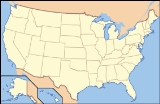
George Washington Birthplace National Monument
Encyclopedia
The George Washington Birthplace National Monument is in Westmoreland County, Virginia
, United States
. Originally settled by John Washington, George Washington
's great-grandfather, George Washington was born here on February 22, 1732. He lived here until age three, returning later as a teenager.
At the entrance to the grounds, now maintained and operated by the National Park Service
, is a Memorial Shaft obelisk
of Vermont marble
, which is a one-tenth scale replica of the Washington Monument
in Washington, D.C.
The George Washington Birthplace National Monument, where Popes Creek joins the Potomac River
, is representative of 18th-century Virginia tobacco farms. A Memorial House with 18th century furnishings is open to visitors. The park's farm buildings, groves of trees, livestock, gardens, and crops of tobacco and wheat, represent the boyhood environment Washington knew.

's great-grandfather settled this plantation in 1657 at the original site on Bridges Creek. The family acquired additional land located on nearby Popes Creek where the first section of the house in which George Washington was born was built before 1718 and enlarged by his father between 1722–1726. It was further enlarged by the mid-1770s to a ten-room house, known as "Wakefield". This house which George Washington in 1792 would describe as "the ancient mansion seat" was destroyed by fire and flood on Christmas Day, 1779, and never rebuilt.
Thirty-two graves of Washington family members have been found at the Bridges Creek cemetery plot,
including George's half-brother, father, grandfather, and great-grandfather.
Washington's father cultivated tobacco
on his several plantations, which was labor intensive, involving the work of enslaved
Africans and African Americans. By the time George Washington was born, the population of the Virginia colony was 50 percent black, most of whom were enslaved. "20 or so" slaves worked on the small tobacco farm at Popes Creek, during the time that Washington lived there.
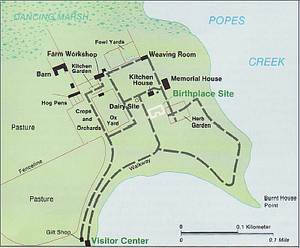
intervened. Virginia donated the land to the Federal Government in 1882.
to acquire and transfer a total of 394 acres (1.6 km²) of land to the Federal government .
Since the exact appearance of the original Washington family home is not known, a Memorial House was designed by Edward Donn, Jr., representing similar buildings of the era and constructed on the approximate site in 1931. The actual location of Washington's boyhood home is adjacent to the memorial house and its foundation is outlined in the ground by crushed oyster shells
.
Constructed as a memorial to George Washington in 1930–1931, the Memorial House is not an exact replica of his birthplace. Rather, it represents a typical upper class house of the period. The Memorial House is constructed of bricks hand-made from local clay. It has a central hallway and four rooms on each floor, furnished in the 1730–1750 period style by the Wakefield National Memorial Association. A tea table is believed to have been in the original house. Most of the other furnishings are more than 200 years old.
The park and Memorial House were opened by the National Park Service in 1932, on the 200th anniversary of George Washington's birth.
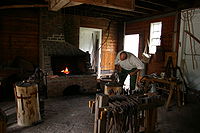
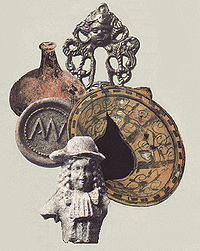 In the 21st century, the Monument is part of the National Park Service's ongoing efforts to interpret historical resources. In addition to the Memorial House, park facilities open to visitors include the historic birthplace home area, Kitchen House, hiking trails, and picnic grounds. In the Kitchen House, costumed re-enactors demonstrate candle- and soap-making.
In the 21st century, the Monument is part of the National Park Service's ongoing efforts to interpret historical resources. In addition to the Memorial House, park facilities open to visitors include the historic birthplace home area, Kitchen House, hiking trails, and picnic grounds. In the Kitchen House, costumed re-enactors demonstrate candle- and soap-making.
A Colonial Herb and Flower Garden, having plants common to Washington's time, such as thyme
, sage, basil
, and other herb
s, flowers such as hollyhock
s, forget-me-not
s, and rose
s, as well as trees and bushes that date to Washington's time, may be viewed. The Colonial Living Farm, with a barn and pasture, raises livestock, poultry, and crops of the 18th century variety, using farming methods common then.
Visitors may also tour the Washington family Burial Ground, which contain the graves of 32 members of the Washington family, including George Washington's father, grandfather, and great-grandfather. Replicas of two original gravestones, along with five memorial tablets placed here in the 1930s, may be viewed.
The Visitors' Center contains artifacts recovered from the burned-down Washington house, such as those pictured at right (clockwise, from right): a bowl, clay figurine, wine bottle seal belonging to Augustine Washington, wine bottle, and keyhole plate.
A 15-minute film depicting Washington family life is shown in a theater at the Visitors' Center.
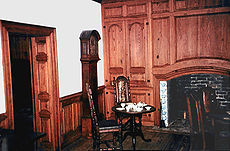 The George Washington Birthplace National Monument is 38 miles (61 km) east of Fredericksburg, Virginia
The George Washington Birthplace National Monument is 38 miles (61 km) east of Fredericksburg, Virginia
, located on Virginia State Route 204, the access road to the site from Virginia State Route 3.
Stratford Hall Plantation
, the birthplace of Robert E. Lee
, and the town of Montross
are nearby.
Westmoreland County, Virginia
As of the census of 2000, there were 16,718 people, 6,846 households, and 4,689 families residing in the county. The population density was . There were 9,286 housing units at an average density of...
, United States
United States
The United States of America is a federal constitutional republic comprising fifty states and a federal district...
. Originally settled by John Washington, George Washington
George Washington
George Washington was the dominant military and political leader of the new United States of America from 1775 to 1799. He led the American victory over Great Britain in the American Revolutionary War as commander-in-chief of the Continental Army from 1775 to 1783, and presided over the writing of...
's great-grandfather, George Washington was born here on February 22, 1732. He lived here until age three, returning later as a teenager.
At the entrance to the grounds, now maintained and operated by the National Park Service
National Park Service
The National Park Service is the U.S. federal agency that manages all national parks, many national monuments, and other conservation and historical properties with various title designations...
, is a Memorial Shaft obelisk
Obelisk
An obelisk is a tall, four-sided, narrow tapering monument which ends in a pyramid-like shape at the top, and is said to resemble a petrified ray of the sun-disk. A pair of obelisks usually stood in front of a pylon...
of Vermont marble
Marble
Marble is a metamorphic rock composed of recrystallized carbonate minerals, most commonly calcite or dolomite.Geologists use the term "marble" to refer to metamorphosed limestone; however stonemasons use the term more broadly to encompass unmetamorphosed limestone.Marble is commonly used for...
, which is a one-tenth scale replica of the Washington Monument
Washington Monument
The Washington Monument is an obelisk near the west end of the National Mall in Washington, D.C., built to commemorate the first U.S. president, General George Washington...
in Washington, D.C.
Washington, D.C.
Washington, D.C., formally the District of Columbia and commonly referred to as Washington, "the District", or simply D.C., is the capital of the United States. On July 16, 1790, the United States Congress approved the creation of a permanent national capital as permitted by the U.S. Constitution....
The George Washington Birthplace National Monument, where Popes Creek joins the Potomac River
Potomac River
The Potomac River flows into the Chesapeake Bay, located along the mid-Atlantic coast of the United States. The river is approximately long, with a drainage area of about 14,700 square miles...
, is representative of 18th-century Virginia tobacco farms. A Memorial House with 18th century furnishings is open to visitors. The park's farm buildings, groves of trees, livestock, gardens, and crops of tobacco and wheat, represent the boyhood environment Washington knew.
History

17th–18th centuries
George WashingtonGeorge Washington
George Washington was the dominant military and political leader of the new United States of America from 1775 to 1799. He led the American victory over Great Britain in the American Revolutionary War as commander-in-chief of the Continental Army from 1775 to 1783, and presided over the writing of...
's great-grandfather settled this plantation in 1657 at the original site on Bridges Creek. The family acquired additional land located on nearby Popes Creek where the first section of the house in which George Washington was born was built before 1718 and enlarged by his father between 1722–1726. It was further enlarged by the mid-1770s to a ten-room house, known as "Wakefield". This house which George Washington in 1792 would describe as "the ancient mansion seat" was destroyed by fire and flood on Christmas Day, 1779, and never rebuilt.
Thirty-two graves of Washington family members have been found at the Bridges Creek cemetery plot,
including George's half-brother, father, grandfather, and great-grandfather.
Washington's father cultivated tobacco
Tobacco
Tobacco is an agricultural product processed from the leaves of plants in the genus Nicotiana. It can be consumed, used as a pesticide and, in the form of nicotine tartrate, used in some medicines...
on his several plantations, which was labor intensive, involving the work of enslaved
Slavery
Slavery is a system under which people are treated as property to be bought and sold, and are forced to work. Slaves can be held against their will from the time of their capture, purchase or birth, and deprived of the right to leave, to refuse to work, or to demand compensation...
Africans and African Americans. By the time George Washington was born, the population of the Virginia colony was 50 percent black, most of whom were enslaved. "20 or so" slaves worked on the small tobacco farm at Popes Creek, during the time that Washington lived there.

19th century
ln 1858, the Commonwealth of Virginia acquired the property to preserve the homesite and cemetery, but the Civil WarAmerican Civil War
The American Civil War was a civil war fought in the United States of America. In response to the election of Abraham Lincoln as President of the United States, 11 southern slave states declared their secession from the United States and formed the Confederate States of America ; the other 25...
intervened. Virginia donated the land to the Federal Government in 1882.
20th century
The Wakefield National Memorial Association was formed in 1923 to restore the property. In 1930, the grounds were authorized as a U.S. National Monument and, in 1931, the Wakefield Association received a grant from John D. Rockefeller, Jr.John D. Rockefeller, Jr.
John Davison Rockefeller, Jr. was a major philanthropist and a pivotal member of the prominent Rockefeller family. He was the sole son among the five children of businessman and Standard Oil industrialist John D. Rockefeller and the father of the five famous Rockefeller brothers...
to acquire and transfer a total of 394 acres (1.6 km²) of land to the Federal government .
Since the exact appearance of the original Washington family home is not known, a Memorial House was designed by Edward Donn, Jr., representing similar buildings of the era and constructed on the approximate site in 1931. The actual location of Washington's boyhood home is adjacent to the memorial house and its foundation is outlined in the ground by crushed oyster shells
Oyster
The word oyster is used as a common name for a number of distinct groups of bivalve molluscs which live in marine or brackish habitats. The valves are highly calcified....
.
Constructed as a memorial to George Washington in 1930–1931, the Memorial House is not an exact replica of his birthplace. Rather, it represents a typical upper class house of the period. The Memorial House is constructed of bricks hand-made from local clay. It has a central hallway and four rooms on each floor, furnished in the 1730–1750 period style by the Wakefield National Memorial Association. A tea table is believed to have been in the original house. Most of the other furnishings are more than 200 years old.
The park and Memorial House were opened by the National Park Service in 1932, on the 200th anniversary of George Washington's birth.
The National Monument today


A Colonial Herb and Flower Garden, having plants common to Washington's time, such as thyme
Thyme
Thyme is a culinary and medicinal herb of the genus Thymus.-History:Ancient Egyptians used thyme for embalming. The ancient Greeks used it in their baths and burnt it as incense in their temples, believing it was a source of courage...
, sage, basil
Basil
Basil, or Sweet Basil, is a common name for the culinary herb Ocimum basilicum , of the family Lamiaceae , sometimes known as Saint Joseph's Wort in some English-speaking countries....
, and other herb
Herb
Except in botanical usage, an herb is "any plant with leaves, seeds, or flowers used for flavoring, food, medicine, or perfume" or "a part of such a plant as used in cooking"...
s, flowers such as hollyhock
Hollyhock
Alcea , commonly known as hollyhocks, is a genus of about 60 species of flowering plants in the mallow family Malvaceae. Most species are native to southwest and central Asia, although a few are native to southeast Europe or Egypt...
s, forget-me-not
Forget-me-not
Myosotis is a genus of flowering plants in the family Boraginaceae that are commonly called Forget-me-nots. Its common name was calqued from the French, "ne m'oubliez pas" and first used in English in c. 1532. Similar names and variations are found in many languages.-Description:There are...
s, and rose
Rose
A rose is a woody perennial of the genus Rosa, within the family Rosaceae. There are over 100 species. They form a group of erect shrubs, and climbing or trailing plants, with stems that are often armed with sharp prickles. Flowers are large and showy, in colours ranging from white through yellows...
s, as well as trees and bushes that date to Washington's time, may be viewed. The Colonial Living Farm, with a barn and pasture, raises livestock, poultry, and crops of the 18th century variety, using farming methods common then.
Visitors may also tour the Washington family Burial Ground, which contain the graves of 32 members of the Washington family, including George Washington's father, grandfather, and great-grandfather. Replicas of two original gravestones, along with five memorial tablets placed here in the 1930s, may be viewed.
The Visitors' Center contains artifacts recovered from the burned-down Washington house, such as those pictured at right (clockwise, from right): a bowl, clay figurine, wine bottle seal belonging to Augustine Washington, wine bottle, and keyhole plate.
A 15-minute film depicting Washington family life is shown in a theater at the Visitors' Center.
Directions

Fredericksburg, Virginia
Fredericksburg is an independent city in the Commonwealth of Virginia located south of Washington, D.C., and north of Richmond. As of the 2010 census, the city had a population of 24,286...
, located on Virginia State Route 204, the access road to the site from Virginia State Route 3.
Stratford Hall Plantation
Stratford Hall Plantation
Stratford Hall Plantation in Westmoreland County, Virginia, was the home of four generations of the Lee family of Virginia, including two signers of the Declaration of Independence, and it was the birthplace of Robert Edward Lee , who became the Confederate General-in-chief during the American...
, the birthplace of Robert E. Lee
Robert E. Lee
Robert Edward Lee was a career military officer who is best known for having commanded the Confederate Army of Northern Virginia in the American Civil War....
, and the town of Montross
Montross, Virginia
Montross is a town in Westmoreland County, Virginia, United States. The population was 315 at the 2000 census. It is the county seat of Westmoreland County. Located in the historic Northern Neck of Virginia, Montross is near the George Washington Birthplace National Monument and Stratford Hall...
are nearby.
See also
- Northern Neck George Washington Birthplace AVANorthern Neck George Washington Birthplace AVAThe Northern Neck George Washington Birthplace AVA is an American Viticultural Area in eastern portion of the state of Virginia. Wines made from grapes grown in Westmoreland, King George, Northumberland, Lancaster, and Richmond counties may use this appellation...
- Montross, VirginiaMontross, VirginiaMontross is a town in Westmoreland County, Virginia, United States. The population was 315 at the 2000 census. It is the county seat of Westmoreland County. Located in the historic Northern Neck of Virginia, Montross is near the George Washington Birthplace National Monument and Stratford Hall...
- National Park ServiceNational Park ServiceThe National Park Service is the U.S. federal agency that manages all national parks, many national monuments, and other conservation and historical properties with various title designations...
- Stratford Hall PlantationStratford Hall PlantationStratford Hall Plantation in Westmoreland County, Virginia, was the home of four generations of the Lee family of Virginia, including two signers of the Declaration of Independence, and it was the birthplace of Robert Edward Lee , who became the Confederate General-in-chief during the American...
- State Route 204, the access road to the site from State Route 3

